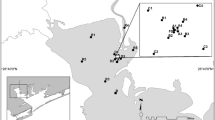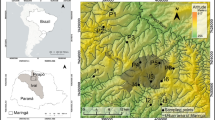Abstract
An international workshop held in the spring of 2002 convened a group of technical experts to address monitoring, modeling, and management of PCBs within the Detroit River-Western Lake Erie basin. Participants shared and discussed a diverse set of research data bases pertaining to PCB levels within the region, discussed observed changes within different components of the local ecosystem, and identified several primary issues impacting future PCB management strategies. Results presented at the workshop indicate dramatic reductions in PCB contamination levels have been observed in much of study area between the late 1970s and mid-1990s. Estimates of loadings attributable to water and atmospheric sources have generally declined, as have PCB concentrations in herring gull eggs, smelt and walleye. Nevertheless, additional improvements have not been observed during recent years and elevated contamination levels remain a concern within local hot spots, particularly in the lower Detroit River and Trenton Channel. A primary recommendation broadly supported by workshop participants is the need to maintain, support, and coordinate a comprehensive ecosystem monitoring program for the Detroit River-Western Lake Erie basin, one that incorporates both near-field and far-field monitoring elements. Such a program is crucial to provide necessary data in support of understanding ecosystem trends, calculating annual mass loadings to the system, assessing impacts of remediation actions, developing improved modeling frameworks, and formulating cost-effective management strategies for the future.
Similar content being viewed by others
References
Corkum, L. D., Ciborowski, J. J. H. and Kovats, Z. E.: 2003, ‘PCBs in Adult Aquatic Insects’, in T. Heidtke, J. Hartig and B. Yu (eds.), Evaluating Ecosystem Results of PCB Control Measures Within the Detroit River-Western Lake Erie Basin, US Environmental Protection Agency, EPA-905-R-03-001, Chicago, IL, pp. 84–88.
Dolan, D.: 2003, ‘Trends in Annual Point Source PCB Loads to the Deroit River, 1986–1998’, in T. Heidtke, J. Hartig and B. Yu (eds.), Evaluating Ecosystem Results of PCB Control Measures Within the Detroit River-Western Lake Erie Basin, US Environmental Protection Agency, EPA-905-R-03-001, Chicago, IL, pp. 45–48.
Drouillard, K. G., Reitsma, S., Tomczak, M. and Haffner, G. D.: 2003, ‘Biomonitors, Surficial Sediments, and Food Web Datasets on the Detroit River’, in T. Heidtke, J. Hartig and B. Yu (eds.), Evaluating Ecosystem Results of PCB Control Measures Within the Detroit River-Western Lake Erie Basin, US Environmental Protection Agency, EPA-905-R-03-001, Chicago, IL, pp. 108–115.
Fernie, K.: 2003, ‘Contaminants and Snapping Turtles: Lake St. Clair, the Detroit River and Western Lake Erie’, in: T. Heidtke, J. Hartig and B. Yu (eds.), Evaluating Ecosystem Results of PCB Control Measures Within the Detroit River-Western Lake Erie Basin, US Environmental Protection Agency, EPA-905-R-03-001, Chicago, IL, pp. 104–107.
Heidtke, T. M., Hartig, J. and Yu, B.: 2003, ‘Evaluating Ecosystem Results of PCB Control Measures Within the Detroit River-Western Lake Erie Basin’, USEPA Report No. EPA-905-R-03-001, USEPA Great Lakes National Programs Office, Chicago, IL.
Hickey, J., Chernyak, S., Begnoche, L. and Quintal, R. T.: 2003, ‘PCBs in Fish Collected from the St. Clair/Detroit River Ecosystem’, in T. Heidtke, J. Hartig and B. Yu (eds.), Evaluating Ecosystem Results of PCB Control Measures Within the Detroit River-Western Lake Erie Basin, US Environmental Protection Agency, EPA-905-R-03-001, Chicago, IL, pp. 92–93.
Letcher, R. J., Li, H., Bennett, E. Drouillard, K. and Haffner, G. D.: 2003, ‘PCB Metabolism and Phenolic Metabolites in the Plasma of Detroit River Fish’, in: T. Heidtke, J. Hartig and B. Yu (eds), Evaluating Ecosystem Results of PCB Control Measures within the Detroit River-Western Lake Erie Basin, US Environmental Protection Agency, EPA-905-R-03-001, Chicago, IL, pp. 94–98.
Marvin, C., Alaee, M., Painter, S. Charlton, M., Kolic, T., MacPherson, K. and Reiner, E.: 2003, ‘PCBs and Other Persistent Organic Pollutants Associated with Detroit River Suspended Sediments’, in T. Heidtke, J. Hartig and B. Yu (eds), Evaluating Ecosystem Results of PCB Control Measures within the Detroit River-Western Lake Erie Basin, US Environmental Protection Agency, EPA-905-R-03-001, Chicago, IL, pp. 63–65.
Morrison, H. A., Whittle, D. M. and Haffner, D.: 2000, ‘The relative importance of species invasions and sediment disturbance in regulating chemical dynamics in Western Lake Erie’, Ecol. Model. 125, 279–294.
Morrison, H. A., Gobas, F. A. P. C., Lazar, R. Whittle, D. M. and Haffner, G. D.: 1998, ‘Projected changes to the trophodynamics of PCBs in the Western Lake Erie ecosystem attributed to the presence of Zebra Mussels (Dreisennia polymorpha)’, Environ. Sci. Technol. 32, 3862–3867.
Nettesheim, T.: 2003, ‘Atmospheric Deposition of PCBs: An Integrated Atmospheric Deposition Network (LADN) Perspective’, in T. Heidtke, J. Hartig and B. Yu (eds), Evaluating Ecosystem Results of PCB Control Measures within the Detroit River-Western Lake Erie Basin, US Environmental Protection Agency, EPA-905-R-03-001, Chicago, IL, pp. 49–53.
Ostaszewski, A.: 2003, ‘PCBs in Sediments – A Remedial Action Plan Perspective’, in T. Heidtke, J. Hartig and B. Yu (eds), Evaluating Ecosystem Results of PCB Control Measures within the Detroit River-Western Lake Erie Basin, US Environmental Protection Agency, EPA-905-R-03-001, Chicago, IL, pp.73–76.
Painter, S., Myers, D. N. and Letterhos, J.: 2000, Characterization of Data and Data Collection Programs for the Lake Erie LaMP’.
Painter, S.: 2003, ‘Lake Erie Lakewide Management Plan Perspective on PCB Sources and Loadings’, in T. Heidtke, J. Hartig and B. Yu (eds), Evaluating Ecosystem Results of PCB Control Measures within the Detroit River-Western Lake Erie Basin, US Environmental Protection Agency, EPA-905-R-03-001, Chicago, IL, pp. 39–44.
Painter, S. and Marvin, C.: 2003, ‘Spatial and Temporal Trends in Lake Erie Sediment PCB Concentrations’, in T. Heidtke, J. Hartig and B. Yu (eds), Evaluating Ecosystem Results of PCB Control Measures within the Detroit River-Western Lake Erie Basin, US Environmental Protection Agency, EPA-905-R-03-001, Chicago, IL, pp. 60–62.
Reitsma, R., Drouillard, K. and Haffner, D.: 2003, ‘Simulation of Sediment Dynamics in the Detroit River Caused by Wind-generated Water Level Changes in Lake Erie and Implications to PCB Contamination’, in: T. Heidtke, J. Hartig and B. Yu (eds), Evaluating Ecosystem Results of PCB Control Measures within the Detroit River-Western Lake Erie Basin, US Environmental Protection Agency, EPA-905-R-03-001, Chicago, IL, pp. 116–120.
Weseloh, D. V. C.: 2003, ‘Spatial and Temporal Trends of PCBs in Herring Gull Eggs from the Western Lake Erie-Detroit River-Southern Lake Huron Corridor, 1974–2001’, in T. Heidtke, J. Hartig and B. Yu (eds), Evaluating Ecosystem Results of PCB Control Measures within the Detroit River-Western Lake Erie Basin, US Environmental Protection Agency, EPA-905-R-03-001, Chicago, IL, pp. 99–103.
Whittle, D. M., Keir, M. J. and Carswell, A. A.: 2003, ‘Western Lake Erie Fish Community Contaminant Trends’, in T. Heidtke, J. Hartig and B. Yu (eds.), Evaluating Ecosystem Results of PCB Control Measures within the Detroit River-Western Lake Erie Basin, US Environmental Protection Agency, EPA-905-R-03-001, Chicago, IL, pp. 89–91.
Author information
Authors and Affiliations
Corresponding author
Rights and permissions
About this article
Cite this article
Heidtke, T., Hartig, J.H., Zarull, M.A. et al. PCB Levels and Trends Within the Detroit River-Western Lake Erie Basin: A Historical Perspective of Ecosystem Monitoring. Environ Monit Assess 112, 23–33 (2006). https://doi.org/10.1007/s10661-006-0212-8
Received:
Accepted:
Issue Date:
DOI: https://doi.org/10.1007/s10661-006-0212-8




